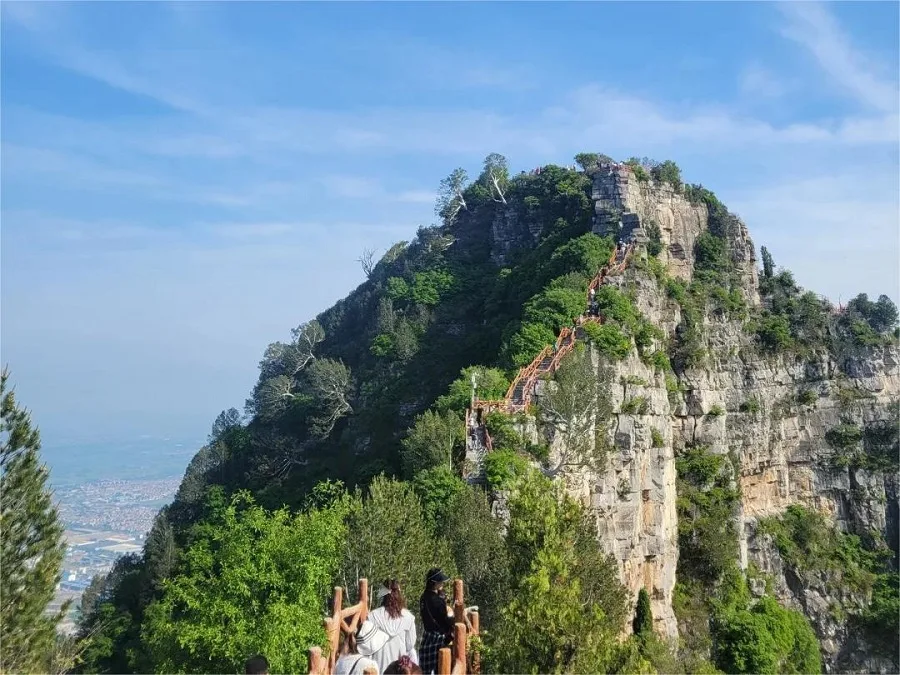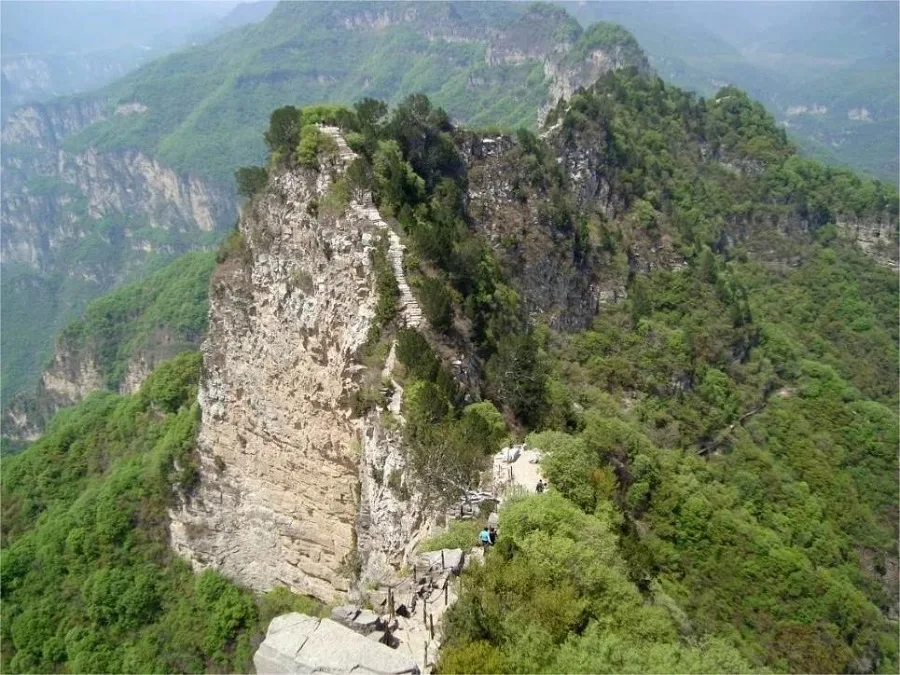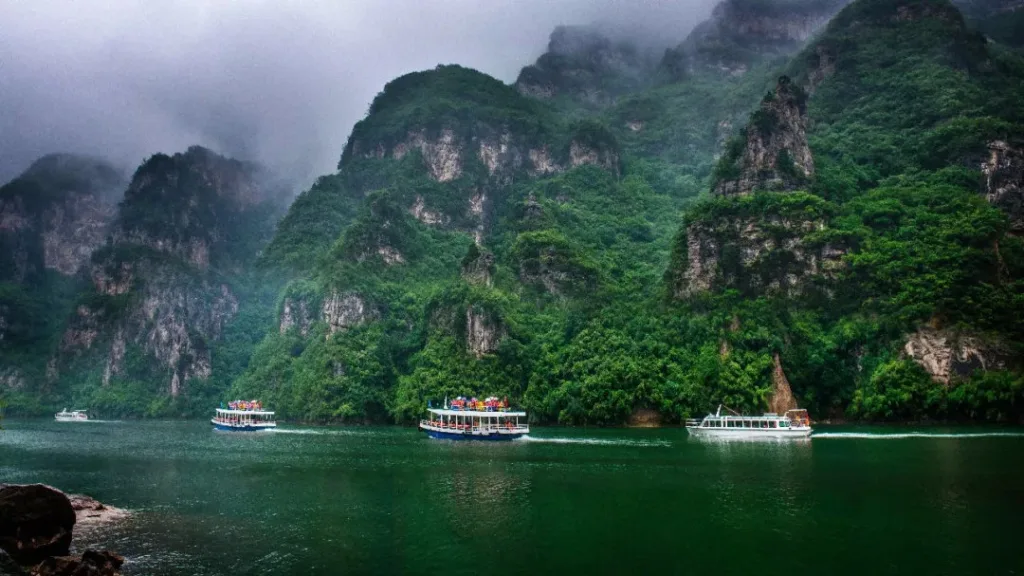Гора Шэньнун, Цзяоцзуо - билет, часы работы, расположение и основные достопримечательности


Jiao Zuo Shennong Mountain Scenic Area (神农山风景名胜区) spans across 102 square kilometers and boasts 136 scenic spots within its expanse. Its main peak, Zijin Peak, rises to an elevation of 1028 meters, with its Three Heavenly Gates predating Mount Tai by 154 years. Legend has it that Shennong, the mythical Yan Emperor, once discerned the properties of various grains and tasted countless herbs while establishing altars for sacrificial offerings here, thus earning the mountain its name. Additionally, it’s believed to be the site where Laozi, the founder of Taoism, practiced alchemy and achieved enlightenment.
The natural beauty of Shennong Mountain is breathtaking. Millennia of geological shifts have crafted a landscape of a thousand peaks competing for prominence, with deep valleys adding to its picturesque allure. The Dragon Ridge Great Wall, a geological wonder, stands as one of the area’s most iconic natural landmarks. Comprising nine peaks resembling the coils of a dragon atop the Taihang Mountains, its undulating contours and stunning vistas leave visitors awestruck.
Recognized as one of the world’s first Global Geoparks, an A-rated priority conservation area by the World Wildlife Fund, and a national-level key scenic spot, Shennong Mountain is also home to a national-level macaque nature reserve and serves as a creative hub for the China Photographers Association.
Оглавление
- Основная информация
- Расположение и транспорт
- Highlights of Shennong Mountain
- Vlog about the Shennong Mountain
- Другие достопримечательности в Цзяоцзуо
Основная информация
| Предполагаемая продолжительность тура | 1 день |
| Цена билета | 65 ЮАНЕЙ |
| Канатная дорога | Upward: 40 RMB Downward: 35 RMB Round-Trip: 70 RMB |
| Трансферный автобус | 25 ЮАНЕЙ |
| Часы работы | 8.00 – 17.30; Last admission: 16.00 |
| Номер телефона | 0086-0391-5036466 0086-0391-5036449 |
Расположение и транспорт
Shennong Mountain is situated in Zhaozhai Village, Ziling Town, Qinyang County, Jiaozuo, Henan Province, China. Its geographical coordinates lie between approximately 35°11′30″ to 35°19′ north latitude and 112°44′ to 113°02′ east longitude. The mountain is approximately 35 kilometers from Jiaozuo and 23 kilometers from Qinyang. Tourists can easily access Shennong Mountain via direct shuttle buses departing every 30 minutes from Jiaozuo Tourist Bus Station and every 15 minutes from Qinyang Bus Station.
Highlights of Shennong Mountain
Zijin Peak (Purple-Gold Peak)

Zijin Peak (紫金顶), also known as the “Northern Peak,” stands as the principal summit of Shennong Mountain, soaring to an elevation of 1028 meters above sea level. Its commanding presence amidst the surrounding mountains earns it the title of the “Jade Pillar of the Middle Sky.” At its peak lies a 1000-square-meter platform surrounded by precipitous cliffs adorned with ancient white pines. Legend has it that Laozi, the Taoist deity, once practiced alchemy here. Throughout the year, the summit is shrouded in purple aura and glistens with golden light, earning it equal acclaim with Wudang Mountain. Additionally, there’s a roughly one-meter deep stone pit known as the “Eight Trigrams Pit,” believed to be where Fuxi, a legendary figure, meditated and conceived the concept of the Eight Trigrams.
Wohu Mountain lies southeast of Zijin Peak, nestled between two valleys. The mountain ridge slopes downward from west to east, culminating in a cliff that resembles a crouching tiger, with discernible features such as its head, ears, and claws. This distinctive formation gives rise to the mountain’s name, which translates to “Crouching Tiger Mountain.”
Jingying Temple

Jingying Temple, dedicated to the Taoist patriarch Zixu Yuanjun (Weihua Cun), commonly referred to as “Erxian Grandmother” due to local beliefs, is situated on a plateau on the eastern bank of the Xianshen River. The temple, facing north, is flanked by the foothills of Zijin Mountain to the east and the Xianshen River to the west. The architectural layout of the temple follows a symmetrical design, surrounded by original walls and embankments. According to records, the temple originally spanned over 100 meters in width and 1500 meters in depth, with some remnants of the original walls still visible. Following reconstruction, the temple complex now covers an area of 38 meters in width and 288 meters in depth, housing structures such as the main hall, East and West Nine-Pavilion Halls, and the Bell and Drum Towers. Numerous archaeological sites dot the temple grounds, providing insights into its rich historical significance.
Dragon Ridge Great Wall

Viewed from the summit of Zijin Peak, a majestic mountain range resembling a winding dragon stretches towards the Taihang Mountains. Its limestone formations, reminiscent of a man-made Great Wall, earned it the picturesque name “Dragon Ridge Great Wall” among geological experts. Rising to a maximum altitude of 1020 meters and spanning approximately 11.5 kilometers, with 2.5 kilometers designated for tourist exploration, the Dragon Ridge Great Wall boasts five unique features: the ridge’s uniqueness, the exceptional pine trees, the remarkable rock formations, the extraordinary pathways, and the breathtaking scenery. Walking along the ridge, visitors are treated to views of sheer cliffs and deep valleys, with each step revealing a new natural wonder. The combination of towering pines, distinctive rock formations, and stunning landscapes makes the Dragon Ridge Great Wall a highlight of Shennong Mountain’s scenic beauty.
Taiping Temple Cliff Carvings

Located in the narrow valley of Taiping Temple Cliff, nestled between precipitous mountains on the western side of the Erxian Temple scenic area, lies an ancient marvel known as the “Little Longmen Grottoes” of northwest Henan Province. Standing atop the eastern ridge of the precipitous mountain, one can discern clear remnants of ancient architectural structures, including a bell pavilion once situated on the ridge’s edge. Continuing along the ridge towards the valley’s mouth, a fork in the mountain path leads to the central Taiping Temple and further to the Mu Jian Mountain to the right, while passing through the mountain gate grants access to the narrow valley. Previously named “Xuan Gu Temple” during the Ming and Qing dynasties, the valley was known as “Narrow Valley Mountain.” During the Northern Wei Dynasty, a monastery was established here, with caves and statues initially carved out, known as the “Taiping Temple Thousand Buddha Caves.” Subsequent dynasties witnessed further carving and embellishment, culminating in the creation of Buddhist sutras and additional cave niches during the Five Dynasties, Jin, Ming, and Qing periods. Despite the monastery’s expansion over the centuries, it fell into disrepair during the Republican era, yet the cliff inscriptions remain preserved on the mountain walls, with six niches still intact within three caves.
Vlog about the Shennong Mountain
Другие достопримечательности в Цзяоцзуо

Гора Юньтай, Цзяоцзуо

Ущелье Фенглин (Ущелье Пикового леса)

Живописная зона реки Цинтянь

Chen Tai Chi Village

Парк озера Лонгюань
Пейзажи Хэнани, Достопримечательности Цзяоцзуо